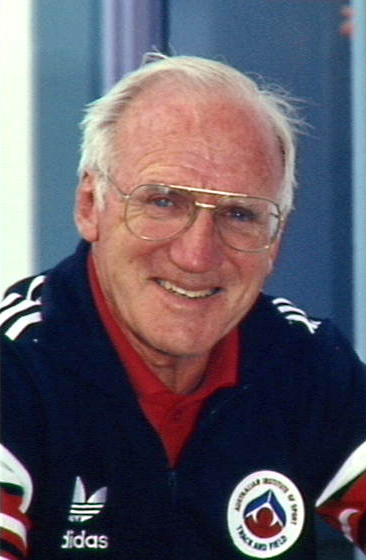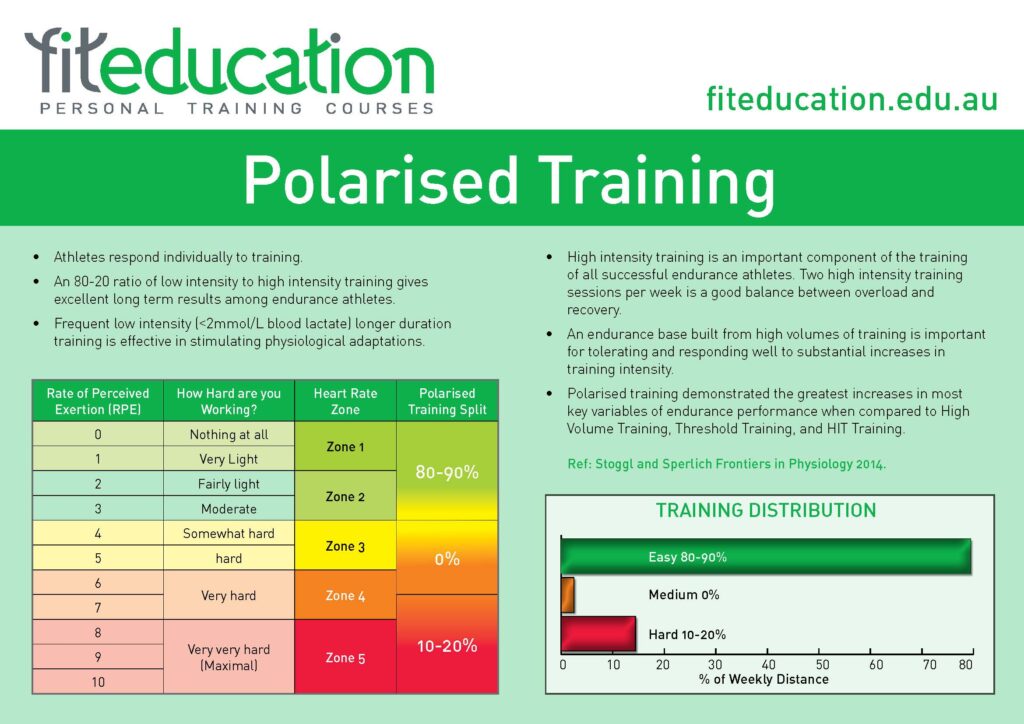THE CONCEPT OF POLARISED TRAINING AND SUCCESSFUL ENDURANCE TRAINING
A review of the literature on polarised training for endurance training.
ABSTRACT
There are many ways to train endurance. Recently in literature, research has shown that the most successful athletes use a polarised approach to endurance training. The purpose of this brief review is to highlight the recent literature regarding polarized endurance training.
The review demonstrates that polarized endurance training plans consistently outperform other endurance training methods including: high-intensity interval training (HIIT), threshold-based training, and high-volume low-intensity training, and combinations. The practical implication for coaches is to incorporate a polarised approach into their exercise prescription and training programs.
Keywords: Polarisation-of-training, polarised-training, endurance-training, HIIT-training, threshold-training
INTRODUCTION
Australia’s and one of the World’s most successful distance athletics coaches, Pat Clohessy tells his athletes to “darn well jog around.” There is method to his relaxed style and coaching method. Science calls it “polarisation of training.” Pat calls it “darn well jogging around!”

Good empirical research on the distribution of training intensity in well trained athletes is fairly new in the sports science literature. The findings highlight a paradox. While athletes perform Olympic endurance events at or above lactate threshold (greater than 85% VO2Max), they complete most of their training at or below lactate threshold intensity.
Research on the most successful endurance athletes (the ones that win) shows a common theme. Their training is polarised, or in simple terms, they either train very hard, or very easy, and do very little of the “in between” training. Research shows that the most successful endurance athletes have an 80, 90/20, 10 % split in their training. I.e. They have a massive volume of very easy training (80-90%) and a small volume of very hard training (10-20%).
So “Darn well jogging around” or training easy, is important to race fast. And that is what puzzles many at all levels of endurance sports. Whether Olympic marathoners run 2.03 marathons or average Joes complete a 5km, they build fast race performances on a volume of easy training. The benefits of easy training are varied, but important when understanding how polarised training works. Easy training allows athletes to build an aerobic base and create physiological adaptions, while not forcing too much fatigue upon the body and allowing the body to recover fully before the next high-intensity session. The purpose of this study is to provide clarity on the existing research by highlighting the recent studies in the field. In addition this review aims to provide practical advice for coaches and athletes as to the polarisation of endurance training.
METHODS
Search Strategy
We conducted a brief review of current literature. We used key word searches such as ‘polarisation’, ‘polarisation AND training’, and ‘endurance training’ in the online databases Google Scholar and SportDiscus. Also, we selected articles from these searches for the review based on the following criteria:
1 The relevance to understanding polarisation of training
2 Their applicability to specific testing and program design.
The reference lists of selected articles were then scanned for additional relevant studies.
Search summary
The keyword searches identified 376 potentially relevant article. 23 of these articles satisfied the selection criteria and were therefore included in this review.

DISCUSSION
Defining Endurance
Endurance has been defined as the ability to maintain or repeat a given force or power output (4). VO2Max, its average maximum fraction maintained during exercise, and economy of movement are the primary factors influencing aerobic performance. Endurance training increases capillary density, the number and volume of mitochondria, activity of oxidative enzymes, and the blood’s capacity to transport oxygen. Lipid oxidation during exercise is a key factor in preserving liver and muscle glycogen stores, which can be depleted when the duration of the event exceeds 90 minutes.

Recent Research
When searching for what works, a lot of people follow what elite runners do and an examination of elite runners demonstrates that easy running forms the majority of their training. Billat undertook studies on marathoners leading up to the Olympic Trials, and a group of elite Kenyan 5km and 10km runners. Researchers analyzed their training using a three-tier approach to categorize the sessions into three zones: 1) easy jogging; 2) threshold; and 3) high-intensity interval training. About 80% of the training for both groups fell into the easy jogging category.
A Spanish study by Munoz (16) on trained distance runners (39.3min ±4.9min), split runners into two groups and had one group train predominately aerobic all with 72/13/13 zone split while the other group focused more on intensity with a 46/37/15 zone split. The result of the study was that the only significant correlation between performance and training was the amount of running in zone 1, as the zone 1 group improved by 7% compared to 1.6% for the intensity group, a significant difference.
Polarized Training vs. Threshold Training
In another Spanish study, two groups of moderately trained runners were split in half and one group trained with a zone distribution of 65/25/10 and the other with 80/10/10 split for five months. Essentially one group did a lot of easy running while the other group focused on threshold training. The result was that both groups improved, however the group that focused on zone 1 (easy running) improved by 157 seconds ± 13 seconds while the threshold group improved by 121.5 seconds ± 7.1 seconds.
In a review article on polarized training, Seiler et al concluded that competitive endurance athletes typically perform about 80% of training sessions at low intensity and dedicate about 20% to high-intensity work.
Neal et al studied 12 well-trained cyclists performing 6 weeks of polarized training and 6 weeks of threshold-focused training, with greater performance benefits resulting from the polarized training.
Munoz et al studied 30 runners. They used polarized or threshold-based training for 10 weeks. Improvements were gauged in a 10k-race. Both groups showed significant improvements. However, a sub-analysis was done. It looked at 12 runners who followed prescribed intensities well. Polarized training proved more effective than threshold-based training.

Polarized Training vs. Threshold Training for Endurance Athletes
In a study by Munoz et al, they quantified the training distribution of 9 recreational Ironman triathletes. They found that doing a larger percentage of training at moderate intensity correlated strongly with worse Ironman performance. On the other hand, training more at low intensity correlated with better Ironman results.
Stöggl and Sperlich analyzed experimental studies lasting from 6 weeks to 5 months. They concluded that polarized training intensity distributions achieved superior responses compared to threshold-based approaches.
Athletes respond differently to training according to the principle of training individualisation. Evidence suggests polarised training is successful at increasing endurance across a wide variety of athletes and sports.
The Importance of High-Intensity and Easy Training for Endurance Athletes
Helgerud et al. demonstrated that high intensity training is an important component of successful endurance athletes. Seiler et al. recommend about 2 high intensity sessions per week seems to strike a good balance between positive effects and stress load (>4mmol/L blood lactate)
Laursen et al demonstrated a point. A basic endurance base from high-volume training is vital. It prepares the body. This base helps tolerate and respond to increased short-term training intensity.
Midgley et al and Seiler et al explored a concept. They believe the distinct impact of high-intensity training and basic endurance might be overstated. Both methods produce similar physiological changes. They likely complement each other..
Easy training generates capillary development, and this is vital as capillaries help deliver oxygen and nutrients to the muscle tissue while waste products are removed. This means that easy training increases the capillaries in the muscle fibre, therefore allowing the body to deliver oxygen and fuel more efficiently. Easy running also increases mitochondrial density that enables us to burn more fat to create more fuel during exercise. The increased Activity of oxidative enzymes, and the blood’s capacity to transport oxygen are other benefits of easy training.

The Importance of Easy Training for Endurance Athletes
At an easy level, adaptations can happen. But pushing harder in easy training doesn’t always increase adaptations. However, fatigue does increase. Keeping training easy ensures the athlete stays fresh. This means high-quality work at intensity. It can be maximized. Every hard session is a source of stress but also a signal for adaptation. The studies state between 55-75% of max HR or the pace at which an athlete can hold a conversation is the correct intensity for easy. If using Max HR as a guide these intensities are applicable:
- Training around 65% of VO2Max counts as low intensity.
- Training at about 90% of VO2Max counts as high intensity.
- Training between 65% and 90% of maximum heart rate counts as moderate intensity.
Alternatively, if training is based on blood lactate levels, the following intensity zones are used:
- Training at less than 2mmol/L blood lactate counts as low intensity.
- Training at greater than 4mmol/L blood lactate counts as high intensity.
- Training between 2 and 4mmol/L blood lactate counts as moderate intensity.
CONCLUSIONS AND PRACTICAL APPLICATIONS
Polarised training is a sustainable and productive way to train for endurance. Polarised approaches consistently excel. They outperform other methods. These include HIIT, threshold-based training, and high-volume low-intensity training. They also beat combinations. The split of 80%-90% Easy and 10-20% Hard or polarisation of training is consistently used by the most successful athletes. Frequent low intensity (<2mmol/L blood lactate or 65% of VO2Max) longer duration training is effective in stimulating physiological adaptations. High intensity training is also an important component of successful endurance athletes. About 2 high intensity sessions per week seems to strike a good balance between positive effects and stress load (>4mmol/L blood lactate or 90% of VO2Max). It is recommended that endurance coaches utilise a polarised approach in their training. This review has provided appropriate guidelines for implementation of a polarised training program.

If you enjoyed this article , try reading the 12 Tips For Successful Coaching, or Strategies For Success.
Learn about polarised training and more in the Diploma of Sport and Diploma of Fitness.
If you have are interested in studying to work in the Fitness Industry, you can schedule a phone call with our Careers Adviser, just click in the image below.

